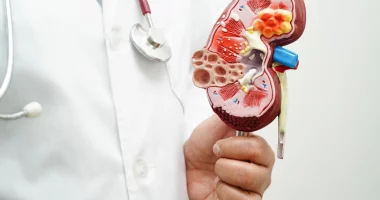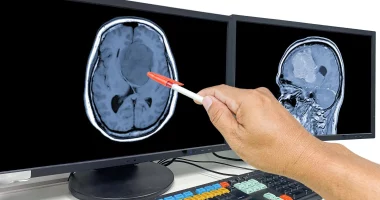An aortic dissection occurs when there are tears in the aorta’s inner layer, the important artery that carries blood from the heart to the rest of the body. These tears allow blood to flow between the layers of the aorta, causing the inner and outer layers to separate.
This condition is very serious and requires immediate medical attention. It can become life-threatening if the blood flows through the outer layer of the aorta.
It is rare. It affects about 5 to 30 population per million every year, mostly aged men.
In this, we will explain the two kinds of aortic dissection, their signs, available treatments, and what individuals with this condition can expect.
Symptoms
Aortic dissection can be difficult to diagnose because its symptoms are similar to those of other serious and more common conditions. Therefore, it’s essential for individuals with determinants, such as hypertension or a hereditary aortic dissection, to have routine heart checkups with their healthcare provider.
Symptoms of aortic dissection typically appear suddenly after the tear takes place. These symptoms often mimic those of heart issues along with heavy pain in the back, chest, or lower stomach (which happens in up to 90 out of 100 cases), difficulty in speaking and walking, anxiety, a weak and fast pulse in single leg or arm, leg pain, unconsciousness, nausea, one part of the body is affected by paralysis, breath shortness, weakness, and sweating.
Types of Aortic Dissection
Aortic dissection is classified into two main types:
- Type A Aortic Dissection: This is the most usual and most dangerous form. It happens when there is a tear in the upper part of the aorta, known as ascending aorta. The tear can extend down towards the lower stomach.
- Type B Aortic Dissection: This type occurs when there is an injury in the lower part of the aorta, known as the descending aorta.
Classification by Duration and Complications
Doctors may also categorize aortic dissection based on the duration of the tear and the presence of complications:
- The tear that has occurred within the past 14 days is acute.
- The tear has been present for 14 days or longer is chronic.
- The tear has caused additional problems, such as reduced blood flow to certain organs is complicated
- The tear has not caused any further complications is uncomplicated
Causes and Risk Factors
Aortic dissection happens when a sick area of the aorta lining tears or rips. Several factors can increase a person’s chance of experiencing this condition.
Age and Gender
Most of the cases of aortic dissection take place between 50 and 65 aged males. Although men are more commonly affected, women can also develop this condition at any age. Interestingly, while fewer women face aortic dissection, they may have worse results compared to men.
Hypertension
Long-time hypertension, or high blood pressure, increases the pressure on the artery lining, allowing it more liable to tearing.
Genetic Disorders
Certain genetic conditions significantly raise the chance of aortic dissection. They also include other conditions, which are
- Marfan syndrome
- Turner syndrome
- clEDS type 2 syndrome
Inflammatory or Infectious Conditions
Infections like syphilis or inflammatory conditions such as big cell arteritis or Takayasu’s arteritis can also elevate the chance of a condition called aortic dissection.
Additional Arterial Issues
Preexisting issues with the aorta can make it more likely to tear. These problems involve:
- Artery hardening (atherosclerosis)
- Valve defects
- Aortic coarctation
- A bulging and weak artery
Chest Trauma
Severe chest injuries can sometimes cause a rupture in the trunk artery.
Pregnancy
Although rare, artery dissections can happen during pregnancy.
Usage of Cocaine
Usage of Cocaine increases blood pressure, which raises the chance of aortic dissection.
Heavy Weightlifting
Engaging in high-resistance training can raise blood pressure to levels that might cause an aortic injury.
When to consult a Doctor
If you experience any signs of aortic dissection or have another serious heart problem, call 911 right away. Aortic dissection is very dangerous and can lead to organ damage or death if not treated quickly. Immediate medical attention is crucial to prevent these severe outcomes.
Diagnosis
To determine aortic dissection healthcare provider will first take your health history and perform a physical test. They will look for specific symptoms and signs such as:
- An irregular heartbeat
- Variations in pressure of blood readings between the right and left arms.
- Sudden, severe pain in the back, chest, or abdomen
To confirm aortic dissection, doctors typically use imaging tests, including:
- Chest X-ray: This can show if the aorta is widened. However, in 10 to 20 out of 100 people with this condition, the X-ray may appear normal, so other tests are often needed.
- Transesophageal Echocardiogram: In this test, a probe is placed down the esophagus (food pipe) near the artery. Sound waves create a picture of the heart, allowing the doctor to look for any abnormalities.
- Aortic Angiogram: The doctor injects a contrast dye into the arteries and then takes X-rays. The dye helps highlight any problems in the artery.
- Magnetic Resonance Angiogram: This exam utilizes radio waves and magnetic fields to create detailed images of the arteries.
In addition to these imaging tests, doctors may also perform blood tests to rule out other conditions with the same symptoms, such as a heart stroke.
Treatment
Instant treatment is essential for main artery dissection to stop serious complexities or death. Treatment commonly involves surgery, medications, or both.
Medicines
For people with type B aortic dissection, doctors usually prescribe medications such as nitroprusside and beta-blockers. These medications help lower the systolic blood pressure and heart rate to stop the injury from worsening.
Individuals with type A aortic dissection may also be given these treatments to stabilize their situation, but they need medical procedures as well.
Most individuals who experience an aortic dissection will be required to take blood pressure-lowering medications throughout their lifetimes to prevent further issues.
Surgery
For type A aortic dissection, surgery is often necessary. The procedure involves removing the damaged part of the main artery and replacing it with a synthetic tube to prevent blood from leaking into the aortic line. If the aortic valve is leaking, the surgeon will also replace it.
For type B aortic dissection can also need surgery. This can include the utilization of stents—tiny mesh tubes that help restore the aorta.
Continuous Treatment
After initial treatment, ongoing care is crucial. This includes taking blood pressure treatments for life and having scans regularly to observe the condition. These scans help doctors ensure that the aorta is stable and catch any potential problems early.
Prevention
People at the chance of increasing aortic dissection, such as those with a hereditary condition, can take several lifestyle measures to decrease their risk.
Heart checkups are essential to monitor heart health. Keeping track of blood pressure and receiving medication for high blood pressure is crucial, it is a significant risk factor.
A healthy diet is important. Eating plenty of whole fruits, grains, and vegetables while reducing salt intake can help maintain cardiovascular health. Regular exercise and sustaining a healthy body mass also contribute to overall heart health and reduce the risk of aortic dissection.
Avoiding smoking is another critical preventive measure, as smoking can damage blood vessels and increase blood pressure.
It’s also important to follow treatment plans for any ongoing medical conditions that could increase the chance of aortic dissection. Finally, using a seat belt in the car can help prevent chest injuries, which can contribute to aortic dissection.
Outlook and Survival
Aortic dissection is extremely severe and carries a high mortality rate. About 40% of the population dies after reaching the emergency room, and 20 to 30 out of 100 people pass away after surgery.
The most dangerous time for aortic dissection is in the first 10 days. Without treatment, the chance of death goes up by 1% for every hour.
Complications of aortic dissection can include organ damage, internal bleeding, and stroke.
For the possibility of recovery, it’s crucial to seek immediate medical help by calling 911 or going to the emergency room if you experience any symptoms of aortic dissection. Advanced treatment can save your life.
Summary
Aortic dissection is a serious condition that requires immediate medical attention. With a high rate of mortality, early detection and prompt treatment are crucial for survival. Lifestyle changes such as regular checkups, maintaining a healthy diet, and avoiding smoking can help reduce the risk of aortic dissection.
Following a treatment plan for underlying medical conditions and wearing seat belts in cars are additional preventive measures. Despite its severity, understanding the symptoms and seeking early medical intervention can significantly improve the outlook for individuals affected by aortic dissection.









